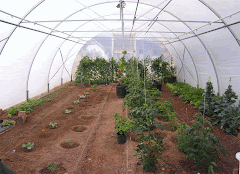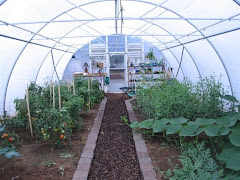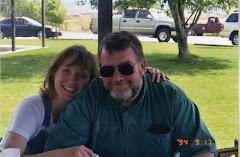
I am always on the lookout for preparedness type articles. I learn so much from them. So many people with so much knowledge.
5 - HOW OLD CAN A BEAN BE?!
5 - HOW OLD CN A BEAN BE?The following comes from a newsletter putout by the Wooden Spoon, December 2006.“In a recent cooking class at The Wooden Spoon we were discussing the shelf life of legumes, which is recommended as 6-8 plus years. True confessions were coming from our students, some of whom inherited their mother's food storage . . .“We determined on an experiment.“Charleen Clark told us that she knew she had beans that were at least 40 years old, and accepted the assignment to go home and see what she could do with them.[She] added 1/8 tsp. baking soda and 1 tbsp. cooking oil to a cup of beans while soaking them in three times as much water. She put the beans to soak on a Saturday morning and left them for thirty-two hours, until she observed that the forty year old beans were beginning to sprout! Charleen drained the rinse water, cooked the beans, and brought them to class.“Christine Van Wagenen, teacher and cook extra ordinaire, put her discriminating palate to the test and sampled a bean and declared the results to be a marvel.~~~~~~General Information About Beans:Nutritious, filling, versatile, economical, and tasty - sounds like the perfect food!SortingSorting means picking over the dried beans before cooking them. Remove small rocks, pieces of dirt, beans with holes, badly misshapen or wrinkled beans and those greatly undersized or discolored.RinsingWashing is not part of the packing process because water would rehydrate the beans. Do not rinse beans until you are ready to soak or cook them. Even then you do not have to rinse beans if you're going to soak them. Any field dust will be removed and discarded with the soak water. If you cook the beans without soaking, rinse them after sorting.SoakingSoaking is not essential in bean preparation. Beans are soaked to begin rehydration and reduce cooking time..During soaking, beans increase two to three times their dried size. Enough water must be used to keep the beans covered while soaking. Once rehydrated, beans cook in 1 to 3 hours, depending on the type of bean.Cooking Without SoakingTo cook beans without soaking, use twice the amount of cooking water specified in the recipe. Combine the water and rinsed beans in the pot and bring to a boil. Cover the pot and reduce the heat to maintain a simmer. The beans rehydrate while cooking so you will have to watch them carefully and add more water whenever necessary to keep them covered.Things to avoid when cooking dry beansAdd only after beans are softThe following items will toughen uncooked beans and noticeably increase cooking time. * salt / unrefined sea salt * miso, tamari and soy sauce * sugars * acidic ingredients, including tomatoes, vinegar, and lemon.Baking soda?Many recipes call for baking soda to speed cooking and soften beans by increasing alkalinity. Use it only if you have extremely hard water. Baking soda will produce mushy beans, and deplete minerals.~~~~BEAN NUTRITIONPROTEIN:Dry beans are the richest source of vegetable protein (21-27% when cooked). Combining beans with a small amount of animal protein such as meat, cheese, or egg or small amounts of grain (corn, wheat, or rice) will create a complete protein equal to that of meat and other animal sources. Protein is important for human health because it supplies the materials for building and repairing body tissues – muscles, bones, glands, skin, and teeth. Beans consistently rank lowest of all foods in cost per gram of protein, according to the USDA.ENERGY: Beans have long been valued as an energy source. Complex carbohydrates in dry beans digest more slowly than simple carbohydrate foods thereby satisfying hunger longer. One half cup of cooked beans contains 118 calories or less.VITAMINS: A normal serving of cooked dry beans supplies as much as 40% of the minimum daily requirement of the B-vitamins, thiamine and pyridoxine, and significant amounts of other B-vitamins. The B-vitamins are important in contributing to healthy digestive and nervous systems, skin, and eyes.MINERALS: Iron to build red blood cells, calcium and phosphorus for strong bones and teeth, and potassium, which is important in regulating body fluid balance, all plentiful in dry beans. Beans are high in fiber, contain no cholesterol, and are low in sodium. Sodium content is low so, when cooked without salt, they are good in low-salt diets.
5 - HOW OLD CN A BEAN BE?The following comes from a newsletter putout by the Wooden Spoon, December 2006.“In a recent cooking class at The Wooden Spoon we were discussing the shelf life of legumes, which is recommended as 6-8 plus years. True confessions were coming from our students, some of whom inherited their mother's food storage . . .“We determined on an experiment.“Charleen Clark told us that she knew she had beans that were at least 40 years old, and accepted the assignment to go home and see what she could do with them.[She] added 1/8 tsp. baking soda and 1 tbsp. cooking oil to a cup of beans while soaking them in three times as much water. She put the beans to soak on a Saturday morning and left them for thirty-two hours, until she observed that the forty year old beans were beginning to sprout! Charleen drained the rinse water, cooked the beans, and brought them to class.“Christine Van Wagenen, teacher and cook extra ordinaire, put her discriminating palate to the test and sampled a bean and declared the results to be a marvel.~~~~~~General Information About Beans:Nutritious, filling, versatile, economical, and tasty - sounds like the perfect food!SortingSorting means picking over the dried beans before cooking them. Remove small rocks, pieces of dirt, beans with holes, badly misshapen or wrinkled beans and those greatly undersized or discolored.RinsingWashing is not part of the packing process because water would rehydrate the beans. Do not rinse beans until you are ready to soak or cook them. Even then you do not have to rinse beans if you're going to soak them. Any field dust will be removed and discarded with the soak water. If you cook the beans without soaking, rinse them after sorting.SoakingSoaking is not essential in bean preparation. Beans are soaked to begin rehydration and reduce cooking time..During soaking, beans increase two to three times their dried size. Enough water must be used to keep the beans covered while soaking. Once rehydrated, beans cook in 1 to 3 hours, depending on the type of bean.Cooking Without SoakingTo cook beans without soaking, use twice the amount of cooking water specified in the recipe. Combine the water and rinsed beans in the pot and bring to a boil. Cover the pot and reduce the heat to maintain a simmer. The beans rehydrate while cooking so you will have to watch them carefully and add more water whenever necessary to keep them covered.Things to avoid when cooking dry beansAdd only after beans are softThe following items will toughen uncooked beans and noticeably increase cooking time. * salt / unrefined sea salt * miso, tamari and soy sauce * sugars * acidic ingredients, including tomatoes, vinegar, and lemon.Baking soda?Many recipes call for baking soda to speed cooking and soften beans by increasing alkalinity. Use it only if you have extremely hard water. Baking soda will produce mushy beans, and deplete minerals.~~~~BEAN NUTRITIONPROTEIN:Dry beans are the richest source of vegetable protein (21-27% when cooked). Combining beans with a small amount of animal protein such as meat, cheese, or egg or small amounts of grain (corn, wheat, or rice) will create a complete protein equal to that of meat and other animal sources. Protein is important for human health because it supplies the materials for building and repairing body tissues – muscles, bones, glands, skin, and teeth. Beans consistently rank lowest of all foods in cost per gram of protein, according to the USDA.ENERGY: Beans have long been valued as an energy source. Complex carbohydrates in dry beans digest more slowly than simple carbohydrate foods thereby satisfying hunger longer. One half cup of cooked beans contains 118 calories or less.VITAMINS: A normal serving of cooked dry beans supplies as much as 40% of the minimum daily requirement of the B-vitamins, thiamine and pyridoxine, and significant amounts of other B-vitamins. The B-vitamins are important in contributing to healthy digestive and nervous systems, skin, and eyes.MINERALS: Iron to build red blood cells, calcium and phosphorus for strong bones and teeth, and potassium, which is important in regulating body fluid balance, all plentiful in dry beans. Beans are high in fiber, contain no cholesterol, and are low in sodium. Sodium content is low so, when cooked without salt, they are good in low-salt diets.








